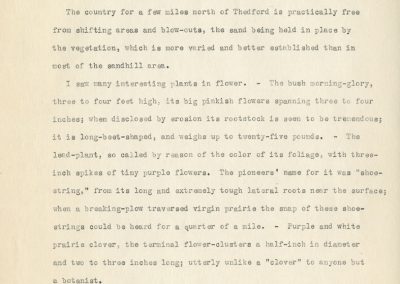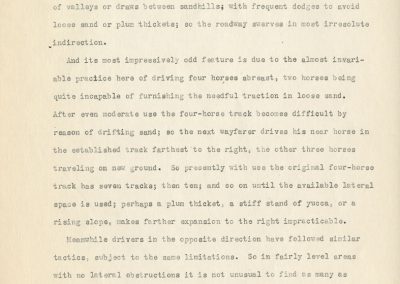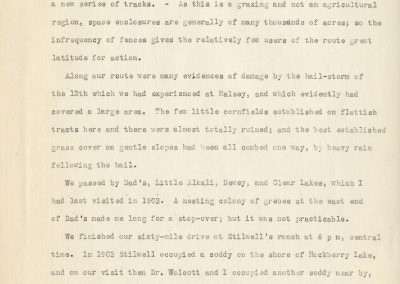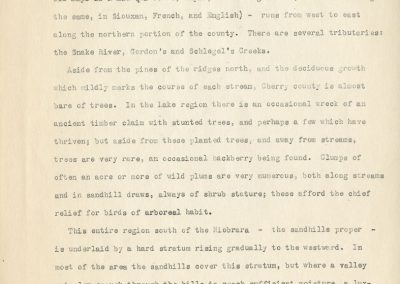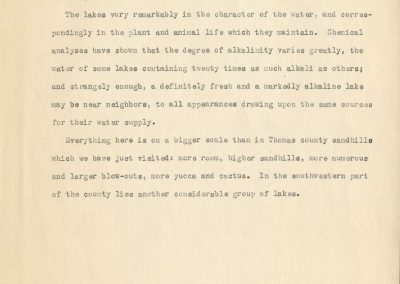Great Nebraska
Naturalists and Scientists
Frank H. Shoemaker
A Drive in the Nebraska Sandhills in 1911
A DRIVE IN THE NEBRASKA SANDHILLS IN 1911
1
We are at Stilwell’s ranch, on the shore of Hackberry Lake in the western part of Cherry county, after a drive of a little over sixty miles from Thedford in Thomas county; Dr. Wolcott, zoologist from the state university; Prof. Williams, botanist from Wesleyan, and myself.
The country for a few miles north of Thedford is practically free from shifting areas and blow-outs, the sand being held in place by the vegetation, which is more varied and better established than in most of the sandhill area.
I saw many interesting plants in flower. — The bush morning-glory, three to four feet high, its big pinkish flowers spanning three to four inches; when disclosed by erosion its rootstock is seen to be tremendous; it is long-boot-shaped, and weighs up to twenty-five pounds. — The lead-plant, so called by reason of the color of its foliage, with three inch spikes of tiny purple flowers. The pioneers’ name for it was “shoestring,” from its long and extremely tough lateral roots near the surface; when a breaking-plow traversed virgin prairie the snap of these shoestrings could be heard for a quarter of a mile. — Purple and white prairie closer, the terminal flower-clusters a half-inch in diameter and two to three inches long; utterly unlike a “clover” to anyone but a botanist.
We reached Brownlee — a post-office and a half-dozen houses — at about 12:30, had dinner there, and went on with Rivers Stilwell, who had driven thirty miles from the ranch to meet us. We had a wagon
2
drawn by four horses, so the going was much easier than the rather crowded first half of the trip.
A wagon route through the sandhills has its placement of course with a definite idea of leading to its objective by the shortest practicable mileage. The lowest usable gradient is selected, the bottoms of valleys or draws between sandhills; with frequent dodges to avoid loose sand or plum thickets; so the roadway swerves in most irresolute indirection.
And its most impressively odd feature is due to the almost invariable practice here of driving four horses abreast, two horses being quite incapable of furnishing the needful traction in loose sand. After even moderate use the four-horse track becomes difficult by reason of drifting sand; so the next wayfarer drives his near horse in the established track farthest to the right, the other three horses traveling on new ground. So presently with use the original four-horse track has seven tracks; then ten; and so on until the available lateral space is used; perhaps a plum thicket, a stiff stand of yucca, or a rising slope, makes further expansion to the right impracticable.
Meanwhile drivers in the opposite direction have followed similar tactics, subject to the same limitations. So in fairly level areas with no lateral obstructions it is not unusual to find as many as twenty tracks side by side, with narrow strips of undisturbed vegetation between them.
Where the available route lies between high hills or other obstruc-
3
tions and this convenient lateral road-extension can not be affected, the tracks concentrate, and this concentration soon leads to hard going because of loosening and deepening sand. So presently some wary driver, afraid of stalling his load in this pass, will lay out an entirely new route for a mile or more, to avoid it; and this pioneer venture starts a new series of tracks. — As this is a grazing and not an agricultural region, pace enclosures are generally of many thousands of acres; so the infrequency of fences gives the relatively few users of the route great latitude of action.
Along our route were many evidences of damage by the hail-storm of the 12th which we had experienced at Halsey, and which evidently had covered a large area. the few little cornfields established on flattish tracts here and there were almost totally ruined; and the best established grass cover on gentle slopes had been combed one way, by heavy rain following the hail.
We passed by Dad’s, Little Alkali, Dewey, and Clear Lakes, which I had last visited in 1903. A nesting colony of grebes at the east end of Dad’s made me long for a stop-over; but it was not practicable.
We finished our sixty-mile drive at Stilwell’s ranch at 6 p.m., central time. In 1903 Stilwell occupied a soddy on the shore of Hackberry Lake, and on our visit then Dr. Wolcott and I occupied another soddy near by, arranged for the accommodation of duck-hunters in season. In 1907, however, the water in the lake rose several feet, and the old place was abandoned, a slightly higher site being chosen near the lake shore
4
a quarter mile north, where a comfortable two-story frame house has been erected.
Cherry county covers 5668 squares miles; it is half as large as Belgium, or the state of Maryland. The Niobrara River — appearing variably on old maps as L’Eau qui Court, Rapid, or Running Water (all names meaning the same, in Siouxan, French, and English) — runs west to east along the northern portion of the county. There are several tributaries; the Snake River, Gordon’s and Schlegel’s [sic] Creeks.
Aside from the pines of the ridges north, and the deciduous growth which wildly marks the course of each stream, Cherry county is almost bare of trees. In the lake region there is an occasional wreck of an ancient timber claim with stunted trees, and perhaps a few which have thriven; but aside from these planted trees, and away from streams, trees are very rare, an occasional hackberry being found. Clumps of often an acre or more of wild plums are very numerous, both along streams and in sandhill draws, always of shrub stature; these afford the chief relief for birds of arboreal habit.
This entire region south of the Niobrara — the sandhills proper — is underlaid by a hard stratum rising gradually to the westward. In most of the area the sandhills cover this stratum, but where a valley cuts low enough through the hills to reach sufficient moisture, a luxuriant growth of grass thrives, and a fine hay valley is the result. Where the cut is still deeper a lake is formed. These lakes are uniformly fed by seepage, occasionally by springs at the western end —
5
or, more accurately, the northwestern end; for with impressive frequency they are elongate in form and their general direction, or trend, is from northwest to southeast. Ordinarily the northwest end is characterized by a boggy tract filled with ferns, until a point near the water is reached, where these is an area of treacherous black mud.
The lakes vary remarkably in the character of the water, and correspondingly in the plant and animal life which they maintain. Chemical analyses have shown that the degree of alkalinity varies greatly, the water of some lakes containing twenty times as much alkali as others; and strangely enough, a definitely fresh and markedly alkaline lake may be near neighbors, to all appearances drawing upon the same sources for their water supply.
Everything here is on a bigger scale than in Thomas county sandhills which we have just visited: more room, higher sandhills, more numerous and larger blow-outs, more yucca and cactus. In the southwestern part of the county lies another considerable group of lakes.

